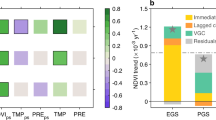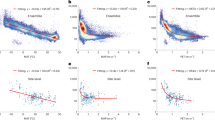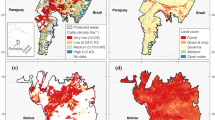Abstract
Terrestrial ecosystem processes, and the associated vegetation carbon dynamics, respond differently to hydrometeorological variability across timescales, and so does our scientific understanding of the underlying mechanisms. Long-term variability of the terrestrial carbon cycle is not yet well constrained and the resulting climate–biosphere feedbacks are highly uncertain. Here we present a comprehensive overview of hydrometeorological and ecosystem variability from hourly to decadal timescales integrating multiple in situ and remote-sensing datasets characterizing extra-tropical forest sites. We find that ecosystem variability at all sites is confined within a hydrometeorological envelope across sites and timescales. Furthermore, ecosystem variability demonstrates long-term persistence, highlighting ecological memory and slow ecosystem recovery rates after disturbances. However, simulation results with state-of-the-art process-based models do not reflect this long-term persistent behaviour in ecosystem functioning. Accordingly, we develop a cross-time-scale stochastic framework that captures hydrometeorological and ecosystem variability. Our analysis offers a perspective for terrestrial ecosystem modelling and paves the way for new model–data integration opportunities in Earth system sciences.
This is a preview of subscription content, access via your institution
Access options
Access Nature and 54 other Nature Portfolio journals
Get Nature+, our best-value online-access subscription
$29.99 / 30 days
cancel any time
Subscribe to this journal
Receive 12 digital issues and online access to articles
$119.00 per year
only $9.92 per issue
Buy this article
- Purchase on Springer Link
- Instant access to full article PDF
Prices may be subject to local taxes which are calculated during checkout






Similar content being viewed by others
References
IPCC Climate Change 2013: The Physical Science Basis (eds Stocker, T. F. et al.) (Cambridge Univ. Press, 2013).
Mitchell, J. M. Jr An overview of climate variability and its causal mechanisms. Quat. Res. 6, 481–493 (1976).
Franke, J., Frank, D., Raible, C. C., Esper, J. & Brönnimann, S. Spectral biases in tree-ring climate proxies. Nat. Clim. Change 3, 360–364 (2013).
Markonis, Y. & Koutsoyiannis, D. Scale-dependence of persistence in precipitation records. Nat. Clim. Change 6, 399–401 (2016).
Baldocchi, D., Falge, E. & Wilson, K. A spectral analysis of biosphere–atmosphere trace gas flux and meteorologiacal variables across hour to multi-year time scales. Agric. For. Meteorol. 107, 1–27 (2001).
Katul, G. et al. Multiscale analysis of vegetation surface fluxes: from seconds to years. Adv. Water Resour. 24, 1119–1132 (2001).
Mahecha, M. D. et al. Characterizing ecosystem–atmosphere interactions from short to interannual time scales. Biogeosciences 4, 743–758 (2007).
Stoy, P. C. et al. Biosphere–atmosphere exchange of CO2 in relation to climate: a cross-biome analysis across multiple time scales. Biogeosciences 6, 2297–2312 (2009).
Mueller, K. L., Yadav, V., Curtis, P. S., Vogel, C. & Michalak, A. M. Attributing the variability of eddy-covariance CO2 flux measurements across temporal scales using geostatistical regression for a mixed northern hardwood forest. Global Biogeochem. Cycles 24, GB3023 (2010).
Farquhar, G. D., von Caemmerer, S. & Berry, J. A. A biochemical model of photosynthetic CO2 assimilation in leaves of C3 species. Planta 149, 78–90 (1980).
Franklin, O. et al. Modeling carbon allocation in trees: a search for principles. Tree Physiol. 32, 648–666 (2012).
Hartmann, H. & Trumbore, S. Understanding the roles of nonstructural carbohydrates in forest trees—from what we can measure to what we want to know. New Phytol. 211, 386–403 (2016).
Koutsoyiannis, D. Generic and parsimonious stochastic modelling for hydrology and beyond. Hydrol. Sci. J. 61, 225–244 (2016).
Dimitriadis, P. & Koutsoyiannis, D. Climacogram versus autocovariance and power spectrum in stochastic modelling for Markovian and Hurst–Kolmogorov processes. Stoch. Environ. Res. Risk Assess. 29, 1649–1669 (2015).
Baldocchi, D. et al. FLUXNET: a new tool to study the temporal and spatial variability of ecosystem-scale carbon dioxide, water vapor, and energy flux densities. Bull. Am. Meteorol. Soc. 82, 2415–2434 (2001).
Hilker, T., Coops, N. C., Wulder, M. A., Black, T. A. & Guy, R. D. The use of remote sensing in light use efficiency based models of gross primary production: a review of current status and future requirements. Sci. Total Environ. 404, 411–423 (2008).
Myneni, R. B. et al. A large carbon sink in the woody biomass of Northern forests. Proc. Natl Acad. Sci. USA 98, 14784–14789 (2001).
Zhu, Z. et al. Global data sets of vegetation leaf area index (LAI)3g and fraction of photosynthetically active radiation (FPAR)3g derived from global inventory modeling and mapping studies (GIMMS) normalized difference vegetation index (NDVI3g) for the period 1981 to 2011. Remote Sens. 5, 927–948 (2013).
Rocha, A. V., Goulden, M. L., Dunn, A. L. & Wofsy, S. C. On linking interannual tree ring variability with observations of whole-forest CO2 flux. Glob. Change Biol. 12, 1378–1389 (2006).
Babst, F. et al. Above-ground woody carbon sequestration measured from tree rings is coherent with net ecosystem productivity at five eddy-covariance sites. New Phytol. 201, 1289–1303 (2014).
Campioli, M. et al. Evaluating the convergence between eddy-covariance and biometric methods for assessing carbon budgets of forests. Nat. Commun. 7, 13717 (2016).
Delpierre, N., Berveiller, D., Granda, E. & Dufrene, E. Wood phenology, not carbon input, controls the interannual variability of wood growth in a temperate oak forest. New Phytol. 210, 459–470 (2016).
Cavanaugh, N. R. & Shen, S. S. P. The effects of gridding algorithms on the statistical moments and their trends of daily surface air temperature. J. Clim. 28, 9188–9205 (2015).
Sitch, S. et al. Recent trends and drivers of regional sources and sinks of carbon dioxide. Biogeosciences 12, 653–679 (2015).
Scheffer, M., Carpenter, S. R., Dakos, V. & Van Nes, E. H. Generic indicators of ecological resilience: inferring the chance of a critical transition. Annu. Rev. Ecol. Evol. Syst. 46, 145–167 (2015).
Ogle, K. et al. Quantifying ecological memory in plant and ecosystem processes. Ecol. Lett. 18, 221–235 (2015).
Anderegg, W. R. L. et al. Pervasive drought legacies in forest ecosystems and their implications for carbon cycle models. Science 349, 528–532 (2015).
Frank, D. et al. Effects of climate extremes on the terrestrial carbon cycle: concepts, processes and potential future impacts. Glob. Change Biol. 21, 2861–2880 (2015).
Reyer, C. P. O. et al. A plant’s perspective of extremes: terrestrial plant responses to changing climatic variability. Glob. Change Biol. 19, 75–89 (2013).
Reichstein, M. et al. Climate extremes and the carbon cycle. Nature 500, 287–295 (2013).
Luo, Y., Keenan, T. F. & Smith, M. J. Predictability of the terrestrial carbon cycle. Glob. Change Biol. 21, 1737–1751 (2015).
Fisher, R. et al. Assessing uncertainties in a second-generation dynamic vegetation model caused by ecological scale limitations. New Phytol. 187, 666–681 (2010).
Medvigy, D., Wofsy, S. C., Munger, J. W., Hollinger, D. Y. & Moorcroft, P. R. Mechanistic scaling of ecosystem function and dynamics in space and time: Ecosystem Demography model version 2. J. Geophys. Res. 114, G01002 (2009).
Scheiter, S., Langan, L. & Higgins, S. I. Next-generation dynamic global vegetation models: learning from community ecology. New Phytol. 198, 957–969 (2013).
Fatichi, S., Leuzinger, S. & Körner, C. Moving beyond photosynthesis: from carbon source to sink-driven vegetation modeling. New Phytol. 201, 1086–1095 (2014).
Körner, C. Paradigm shift in plant growth control. Curr. Opin. Plant Biol. 25, 107–114 (2015).
Pappas, C., Fatichi, S., Leuzinger, S., Wolf, A. & Burlando, P. Sensitivity analysis of a process-based ecosystem model: pinpointing parameterization and structural issues. J. Geophys. Res. Biogeosci. 118, 505–528 (2013).
Fatichi, S., Pappas, C. & Ivanov, V. Y. Modeling plant–water interactions: an ecohydrological overview from the cell to the global scale. Wiley Interdiscip. Rev. Water 3, 327–368 (2016).
Pugh, T. A. M., Müller, C., Arneth, A., Haverd, V. & Smith, B. Key knowledge and data gaps in modelling the influence of CO2 concentration on the terrestrial carbon sink. J. Plant Physiol. 203, 3–15 (2016).
Fernández-Martínez, M. et al. Nutrient availability as the key regulator of global forest carbon balance. Nat. Clim. Change 4, 471–476 (2014).
Aubin, I. et al. Traits to stay, traits to move: a review of functional traits to assess sensitivity and adaptive capacity of temperate and boreal trees to climate change. Environ. Rev. 24, 164–186 (2016).
Lombardozzi, D. L., Bonan, G. B., Smith, N. G., Dukes, J. S. & Fisher, R. A. Temperature acclimation of photosynthesis and respiration: a key uncertainty in the carbon cycle-climate feedback. Geophys. Res. Lett. 42, 8624–8631 (2015).
Medlyn, B. E., Duursma, Ra & Zeppel, M. J. B. Forest productivity under climate change: a checklist for evaluating model studies. Wiley Interdiscip. Rev. Clim. Change 2, 332–355 (2011).
Potter, K. A., Arthur Woods, H. & Pincebourde, S. Microclimatic challenges in global change biology. Glob. Change Biol. 19, 2932–2939 (2013).
Pappas, C., Fatichi, S., Rimkus, S., Burlando, P. & Huber, M. The role of local-scale heterogeneities in terrestrial ecosystem modeling. J. Geophys. Res. Biogeosci. 120, 341–360 (2015).
Sun, Y. et al. Impact of mesophyll diffusion on estimated global land CO2 fertilization. Proc. Natl Acad. Sci. USA 111, 15774–15779 (2014).
Friend, A. D. et al. Carbon residence time dominates uncertainty in terrestrial vegetation responses to future climate and atmospheric CO2. Proc. Natl Acad. Sci. USA 111, 3280–3285 (2014).
Sulman, B. N., Phillips, R. P., Oishi, A. C., Shevliakova, E. & Pacala, S. W. Microbe-driven turnover offsets mineral-mediated storage of soil carbon under elevated CO2. Nat. Clim. Change 4, 1099–1102 (2014).
Friedlingstein, P. & Prentice, I. C. Carbon–climate feedbacks: a review of model and observation based estimates. Curr. Opin. Environ. Sustain. 2, 251–257 (2010).
Ault, T. R., Cole, J. E. & St. George, S. The amplitude of decadal to multidecadal variability in precipitation simulated by state-of-the-art climate models. Geophys. Res. Lett. 39, L21705 (2012).
Dee, D. P. et al. The ERA-Interim reanalysis: configuration and performance of the data assimilation system. Q. J. R. Meteorol. Soc. 137, 553–597 (2011).
Kalnay, E. et al. The NCEP/NCAR 40-year reanalysis project. Bull. Am. Meteorol. Soc. 77, 437–471 (1996).
Kanamitsu, M. et al. NCEP-DOE AMIP-II reanalysis (R-2). Bull. Am. Meteorol. Soc. 83, 1631–1643 (2002).
Whitaker, J. S., Compo, G. P., Wei, X. & Hamill, T. M. Reanalysis without radiosondes using ensemble data assimilation. Mon. Weather Rev. 132, 1190–1200 (2004).
Compo, G. P., Whitaker, J. S. & Sardeshmukh, P. D. Feasibility of a 100-year reanalysis using only surface pressure data. Bull. Am. Meteorol. Soc. 87, 175–190 (2006).
Compo, G. P. et al. The twentieth century reanalysis project. Q. J. R. Meteorol. Soc. 137, 1–28 (2011).
Mitchell, T. D., Carter, T. R., Jones, P. D. & Hulme, M. A Comprehensive Set of High-Resolution Grids of Monthly Climate for Europe and the Globe: the Observed Record (1901–2000) and 16 Scenarios (2001–2100) Working paper no. 55 (Tyndall Centre for Climate Change Research, 2004).
Harris, I., Jones, P. D., Osborn, T. J. & Lister, D. H. Updated high-resolution grids of monthly climatic observations-the CRU TS3.10 dataset. Int. J. Climatol. 34, 623–642 (2014).
Pinty, B. et al. Exploiting the MODIS albedos with the Two-Stream Inversion Package (JRC-TIP): 1. Effective leaf area index, vegetation, and soil properties. J. Geophys. Res. 116, D09105 (2011).
Acknowledgements
This work used eddy covariance data acquired and shared by the FLUXNET community, including these networks: AmeriFlux, AfriFlux, AsiaFlux, CarboAfrica, CarboEuropeIP, CarboItaly, CarboMont, ChinaFlux, Fluxnet-Canada, GreenGrass, ICOS, KoFlux, LBA, NECC, OzFlux-TERN, TCOS-Siberia and USCCC. The FLUXNET eddy covariance data processing and harmonization was carried out by the ICOS Ecosystem Thematic Center, AmeriFlux Management Project and Fluxdata project of FLUXNET, with the support of CDIAC, and the OzFlux, ChinaFlux and AsiaFlux offices. We thank the participants of the TRENDY project, namely, P. Levy (Hyland), S. Sitch and C. Huntingford (JULES/TRIFFID), B. Poulter (LPJ), A. Ahlström (LPJ-GUESS), S. Levis (NCAR-CLM4), N. Viovy, S. Zaehle (OCN), M. Lomas (SDGVM) and N. Zeng (VEGAS), who made their simulations results (TRENDY v.1, experiment S2) freely available. C.P. acknowledges the support of the Stavros Niarchos Foundation and the ETH Zurich Foundation (grant P2EZP2_162293) through a Swiss National Science Foundation (SNSF) Early Postdoc. Mobility fellowship. M.D.M., F.B. and D.C.F. acknowledge funding from the European Union via the Horizon 2020 project ‘BACI’ (grant 640176). F.B. acknowledges funding from the Swiss National Science Foundation (grant P300P2_154543).
Author information
Authors and Affiliations
Contributions
C.P. designed the study, conducted the analysis and wrote the manuscript with input from M.D.M. and D.K. D.C.F. provided the tree-ring width data and F.B. the above-ground biomass increment data. All authors contributed to editing the manuscript.
Corresponding author
Ethics declarations
Competing interests
The authors declare no competing financial interests.
Additional information
Publisher’s note: Springer Nature remains neutral with regard to jurisdictional claims in published maps and institutional affiliations.
Electronic supplementary material
Supplementary Information
Supplementary Tables 1–3, Supplementary Figures 1–18, Supplementary References
Rights and permissions
About this article
Cite this article
Pappas, C., Mahecha, M.D., Frank, D.C. et al. Ecosystem functioning is enveloped by hydrometeorological variability. Nat Ecol Evol 1, 1263–1270 (2017). https://doi.org/10.1038/s41559-017-0277-5
Received:
Accepted:
Published:
Issue Date:
DOI: https://doi.org/10.1038/s41559-017-0277-5
This article is cited by
-
Ecological memory of recurrent drought modifies soil processes via changes in soil microbial community
Nature Communications (2021)



